Daytime Sea Fog Detection Based on a Two-Stage Neural Network
Abstract
1. Introduction
2. Data
2.1. Study Areas
2.2. YBSF Dataset
3. Method
3.1. Pre-Processing
3.2. Distinguish Clear Sky from Clouds and Sea Fog
3.3. Distinguish Sea Fog from Clouds
4. Experimental Results and Analysis
4.1. Image Patch Size Analysis
4.2. Comparison with Other Methods
4.3. Validation with CALIPSO VFM
5. Conclusions
Author Contributions
Funding
Data Availability Statement
Acknowledgments
Conflicts of Interest
References
- Pavolonis, M. GOES-R Advanced Baseline Imager (ABI) Algorithm Theoretical Basis Document for Volcanic Ash; Version 2; NOAA NESDIS Center for Satellite Applications and Research: Silver Spring, MD, USA, 2010. [Google Scholar]
- Hunt, G.E. Radiative properties of terrestial clouds at visible and infra-red thermal window wavelengths. Q. J. R. Meteorol. Soc. 1973, 99, 346–369. [Google Scholar] [CrossRef]
- Eyre, J.; Brownscombe, J.L.; Allam, R.J. Detection of fog at night using Advanced Very High Resolution Radiometer (AVHRR) imagery. Meteorol. Mag. 1984, 113, 266–271. [Google Scholar]
- Ellrod, G.P. Advances in the Detection and Analysis of Fog at Night Using GOES Multispectral Infrared Imagery. J. Weather Forecast. 1995, 10, 606–619. [Google Scholar] [CrossRef]
- Bendix, J.; Thies, B.; Cermak, J.; Nauß, T. Ground Fog Detection from Space Based on MODIS Daytime Data—A Feasibility Study. Weather Forecast. 2005, 20, 989–1005. [Google Scholar] [CrossRef]
- Sun, H.; Sun, Z.B.; Li, Y.C. Metorological Satellite Remote Sensing Spectral Charateristics of Fog. J. Nanjing Institule Meterorol. 2004, 27, 289–301. [Google Scholar] [CrossRef]
- Ma, H.Y.; Li, D.R.; Liu, L.M.; Liang, Y.T. Fog Detection Based on EOS MODIS Data. Geomat. Inf. Sci. Wuhan Univ. 2005, 30, 143–145. [Google Scholar]
- Hao, Z.Z.; Pan, D.L.; Gong, F.; Zhu, Q.K. Optical Radiance Characteristics of Sea Fog Based on Remote Sensing. Acta Opt. Sin. 2008, 28, 2420–2426. [Google Scholar] [CrossRef]
- Zhang, C.G.; He, J.D.; Ma, Z.G. Remote Sensing Monitor of Sea Fog in Fujian Coastal Region. Chin. J. Agrometeorol. 2013, 34, 366–373. [Google Scholar] [CrossRef]
- Zhang, S.P.; Yi, L. A Comprehensive Dynamic Threshold Algorithm for Daytime Sea Fog Retrieval over the Chinese Adjacent Seas. Pure Appl. Geophys. 2013, 170, 1931–1944. [Google Scholar] [CrossRef]
- Wu, X.; Li, S. Automatic sea fog detection over Chinese adjacent oceans using Terra/MODIS data. Int. J. Remote Sens. 2014, 35, 7430–7457. [Google Scholar] [CrossRef]
- Cermak, J.; Bendix, J. A novel approach to fog/low stratus detection using Meteosat 8 data. Atmos. Res. 2008, 87, 279–292. [Google Scholar] [CrossRef]
- Drönner, J.; Egli, S.; Thies, B.; Bendix, J.; Seeger, B. FFLSD—Fast Fog and Low Stratus Detection tool for large satellite time-series. Comput. Geosci. 2019, 128, 51–59. [Google Scholar] [CrossRef]
- Kim, D.; Park, M.-S.; Park, Y.-J.; Kim, W. Geostationary Ocean Color Imager (GOCI) Marine Fog Detection in Combination with Himawari-8 Based on the Decision Tree. Remote Sens. 2020, 12, 149. [Google Scholar] [CrossRef]
- Krizhevsky, A.; Sutskever, I.; Hinton, G.E. ImageNet Classification with Deep Convolutional Neural Networks. In Proceedings of the Neural Information Processing Systems-Volume 1, Lake Tahoe, NV, USA, 3–8 December 2012; pp. 1097–1105. [Google Scholar]
- Girshick, R.; Donahue, J.; Darrell, T.; Malik, J. Rich Feature Hierarchies for Accurate Object Detection and Semantic Segmentation. In Proceedings of the 2014 IEEE Conference on Computer Vision and Pattern Recognition, Washington, DC, USA, 23–28 June 2014; pp. 580–587. [Google Scholar]
- He, K.; Zhang, X.; Ren, S.; Sun, J. Spatial Pyramid Pooling in Deep Convolutional Networks for Visual Recognition. IEEE Trans. Pattern Anal. Mach. Intell. 2015, 37, 1904–1916. [Google Scholar] [CrossRef]
- Yuan, Y.; Lin, L. Self-Supervised Pretraining of Transformers for Satellite Image Time Series Classification. IEEE J. Sel. Top. Appl. Earth Obs. Remote Sens. 2021, 14, 474–487. [Google Scholar] [CrossRef]
- Si, G.; Fu, R.D.; He, C.F.; Jin, W. Daytime sea fog recognition based on remote sensing satellite and deep neural network. J. Optoelectron·Laser 2020, 31, 1074–1082. [Google Scholar] [CrossRef]
- Jeon, H.-K.; Kim, S.; Edwin, J.; Yang, C.-S. Sea Fog Identification from GOCI Images Using CNN Transfer Learning Models. Electronics 2020, 9, 311. [Google Scholar] [CrossRef]
- Simonyan, K.; Zisserman, A. Very Deep Convolutional Networks for Large-Scale Image Recognition. In Proceedings of the Learning Representations, San Diego, CA, USA, 7–9 May 2015; pp. 1–14. [Google Scholar]
- He, K.; Zhang, X.; Ren, S.; Sun, J. Deep Residual Learning for Image Recognition. In Proceedings of the 2016 IEEE Conference on Computer Vision and Pattern Recognition (CVPR), Las Vegas, NV, USA, 27–30 June 2016; pp. 770–778. [Google Scholar]
- Zhou, Y.; Chen, K.; Li, X. Dual-Branch Neural Network for Sea Fog Detection in Geostationary Ocean Color Imager. IEEE Trans. Geosci. Remote Sens. 2022, 60, 1–17. [Google Scholar] [CrossRef]
- Zhang, S.-P.; Xie, S.-P.; Liu, Q.-Y.; Yang, Y.-Q.; Wang, X.-G.; Ren, Z.-P. Seasonal Variations of Yellow Sea Fog: Observations and Mechanisms. J. Clim. 2009, 22, 6758–6772. [Google Scholar] [CrossRef]
- Wang, Y.; Gao, S.; Fu, G.; Sun, J.; Zhang, S. Assimilating MTSAT-Derived Humidity in Nowcasting Sea Fog over the Yellow Sea. Weather Forecast. 2014, 29, 205–225. [Google Scholar] [CrossRef]
- Binhua, W. Sea Fog; China Ocean Press: Beijing, China, 1983. [Google Scholar]
- Gao, S.; Lin, H.; Shen, B.; Fu, G. A heavy sea fog event over the Yellow Sea in March 2005: Analysis and numerical modeling. Adv. Atmos. Sci. 2007, 24, 65–81. [Google Scholar] [CrossRef]
- Bessho, K.; Date, K.; Hayashi, M.; Ikeda, A.; Imai, T.; Inoue, H.; Kumagai, Y.; Miyakawa, T.; Murata, H.; Ohno, T.; et al. An Introduction to Himawari-8/9— Japan’s New-Generation Geostationary Meteorological Satellites. J. Meteorol. Soc. Jpn. 2016, 94, 151–183. [Google Scholar] [CrossRef]
- Chunyang, Z.; Jianhua, W.; Shanwei, L.; Hui, S.; Yanfang, X. Sea Fog Detection Using U-Net Deep Learning Model Based On Modis Data. In Proceedings of the 2019 10th Workshop on Hyperspectral Imaging and Signal Processing: Evolution in Remote Sensing (WHISPERS), Amsterdam, The Netherlands, 24–26 September 2019; pp. 1–5. [Google Scholar]
- Yi, L.; Zhang, S.P.; Thies, B.; Shi, X.M.; Trachte, K.; Bendix, J. Spatio-temporal detection of fog and low stratus top heights over the Yellow Sea with geostationary satellite data as a precondition for ground fog detection—A feasibility study. Atmos. Res. 2015, 151, 212–223. [Google Scholar] [CrossRef]
- Winker, D.M.; Pelon, J.; Coakley, J.A.; Ackerman, S.A.; Charlson, R.J.; Colarco, P.R.; Flamant, P.; Fu, Q.; Hoff, R.M.; Kittaka, C.; et al. The CALIPSO Mission: A Global 3D View of Aerosols and Clouds. Bull. Am. Meteorol. Soc. 2010, 91, 1211–1230. [Google Scholar] [CrossRef]
- Gultepe, I.; Tardif, R.; Michaelides, S.C.; Cermak, J.; Bott, A.; Bendix, J.; Müller, M.D.; Pagowski, M.; Hansen, B.; Ellrod, G.; et al. Fog Research: A Review of Past Achievements and Future Perspectives. Pure Appl. Geophys. 2007, 164, 1121–1159. [Google Scholar] [CrossRef]
- Zhang, P.; Wu, D. Daytime Sea Fog Detection Method using Himawari-8 Data. J. Atmos. Environ. Opt. 2019, 14, 211–220. [Google Scholar] [CrossRef]
- Wu, D.; Lu, B.; Zhang, T.; Yan, F. A method of detecting sea fogs using CALIOP data and its application to improve MODIS-based sea fog detection. J. Quant. Spectrosc. Radiat. Transf. 2015, 153, 88–94. [Google Scholar] [CrossRef]
- Lu, B. CALIOP Sea Fog Detection and Its Application to the Daytime Modis Remote Sensing of Sea Fog. Master’s Thesis, Ocean University of China, Qingdao, China, 2015. [Google Scholar]
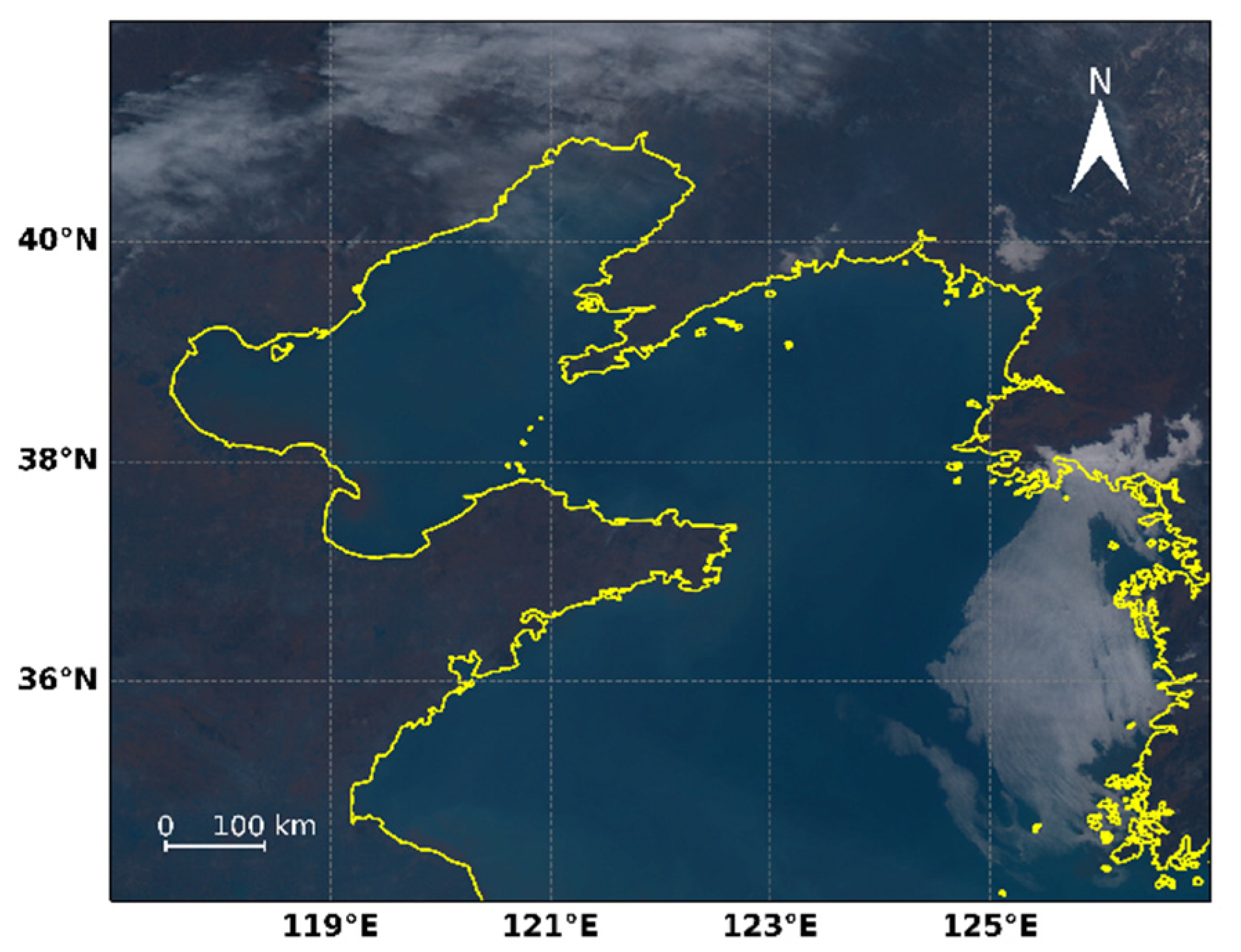
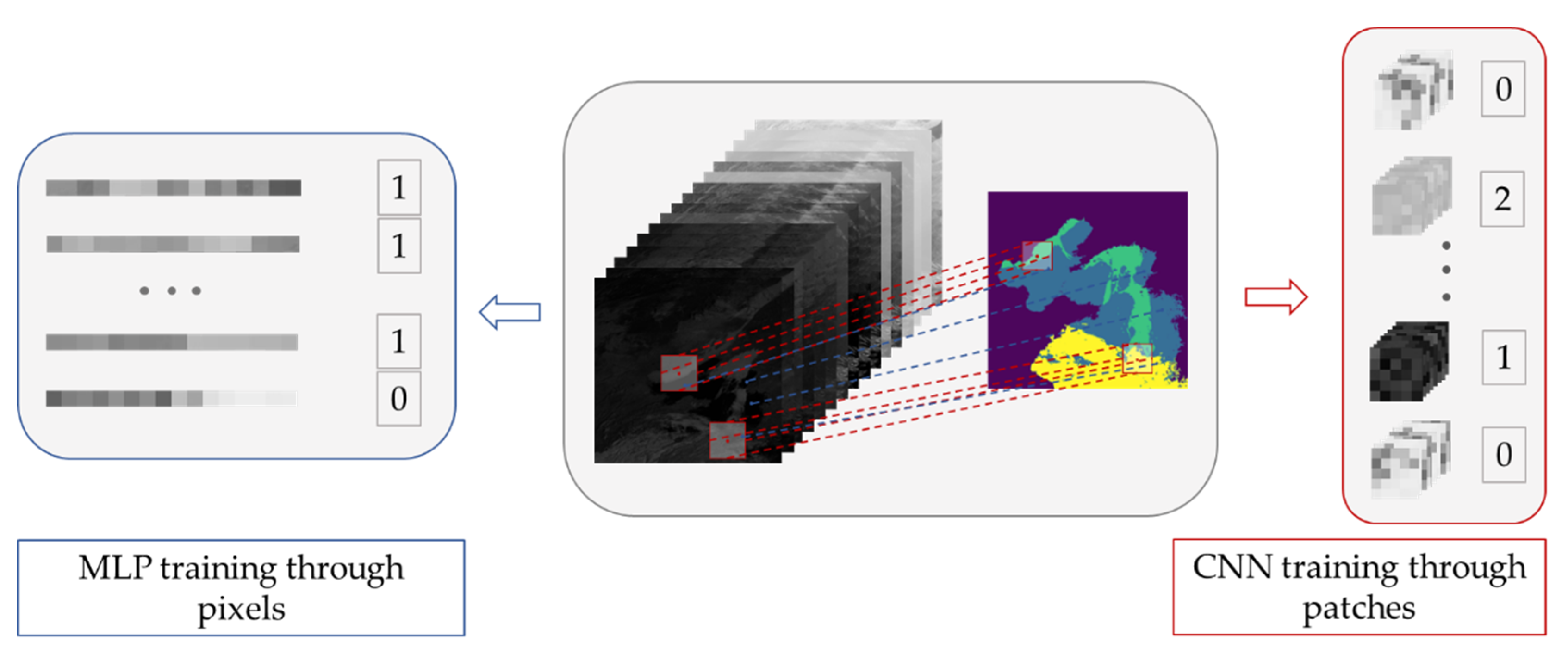

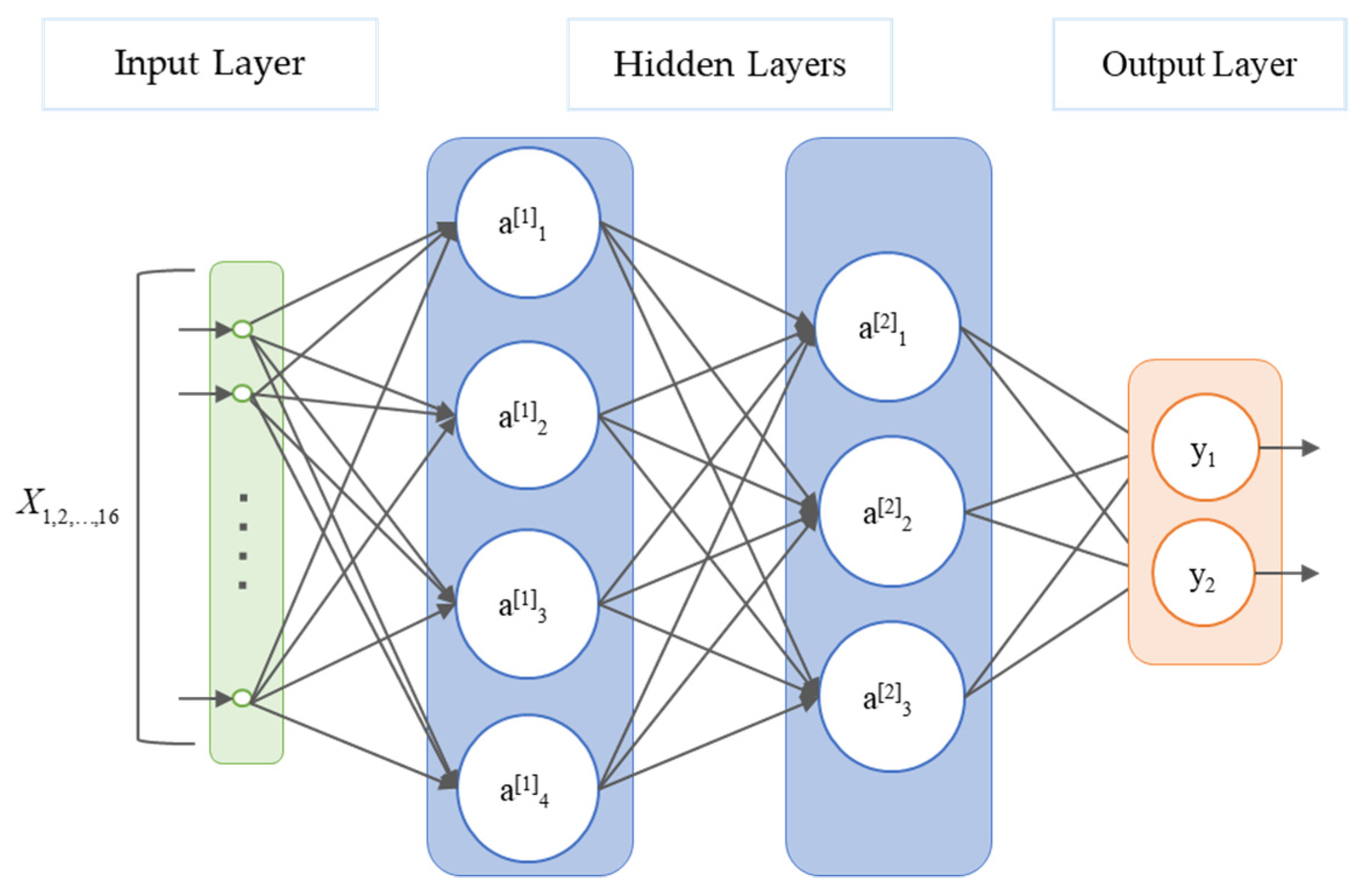
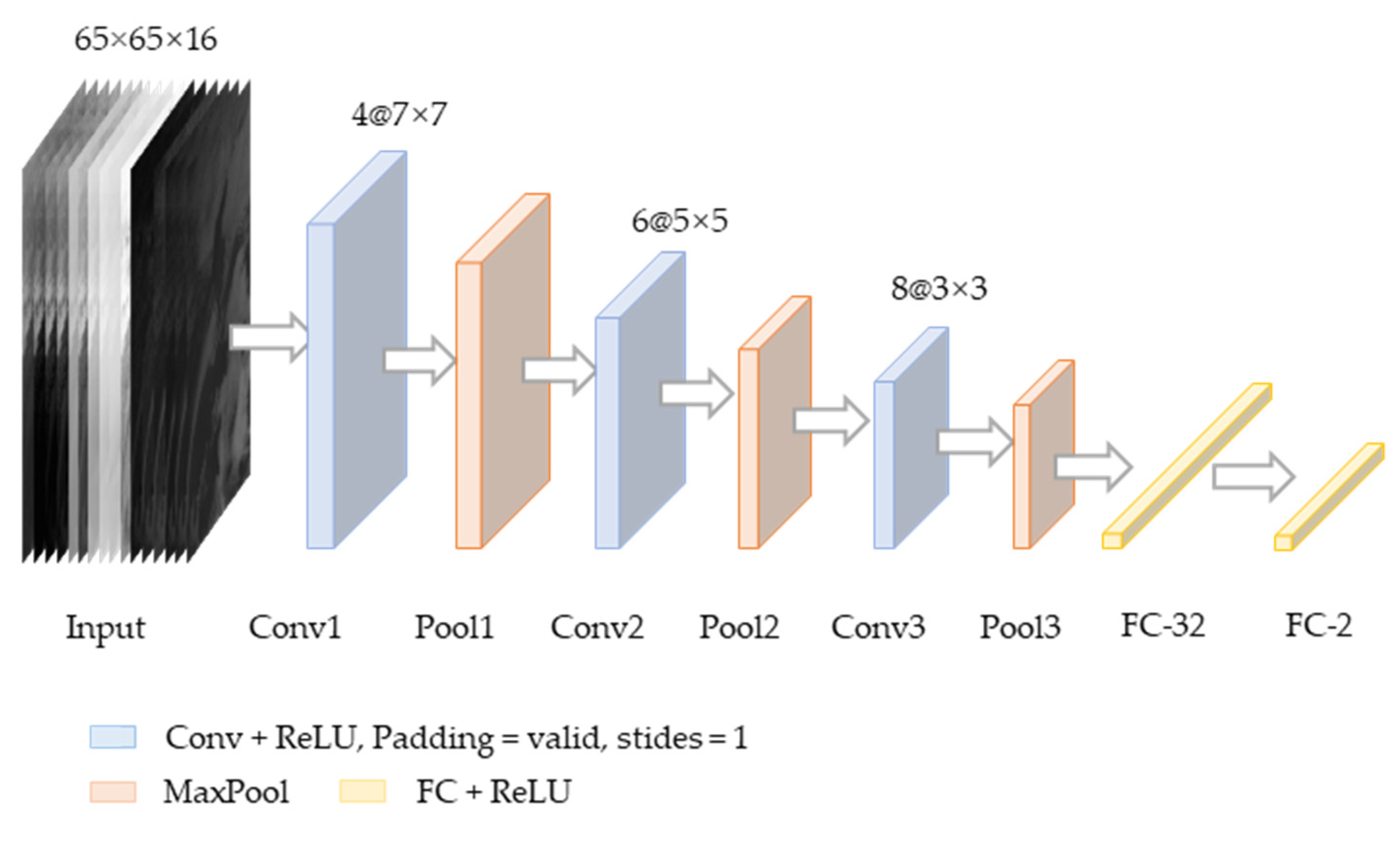
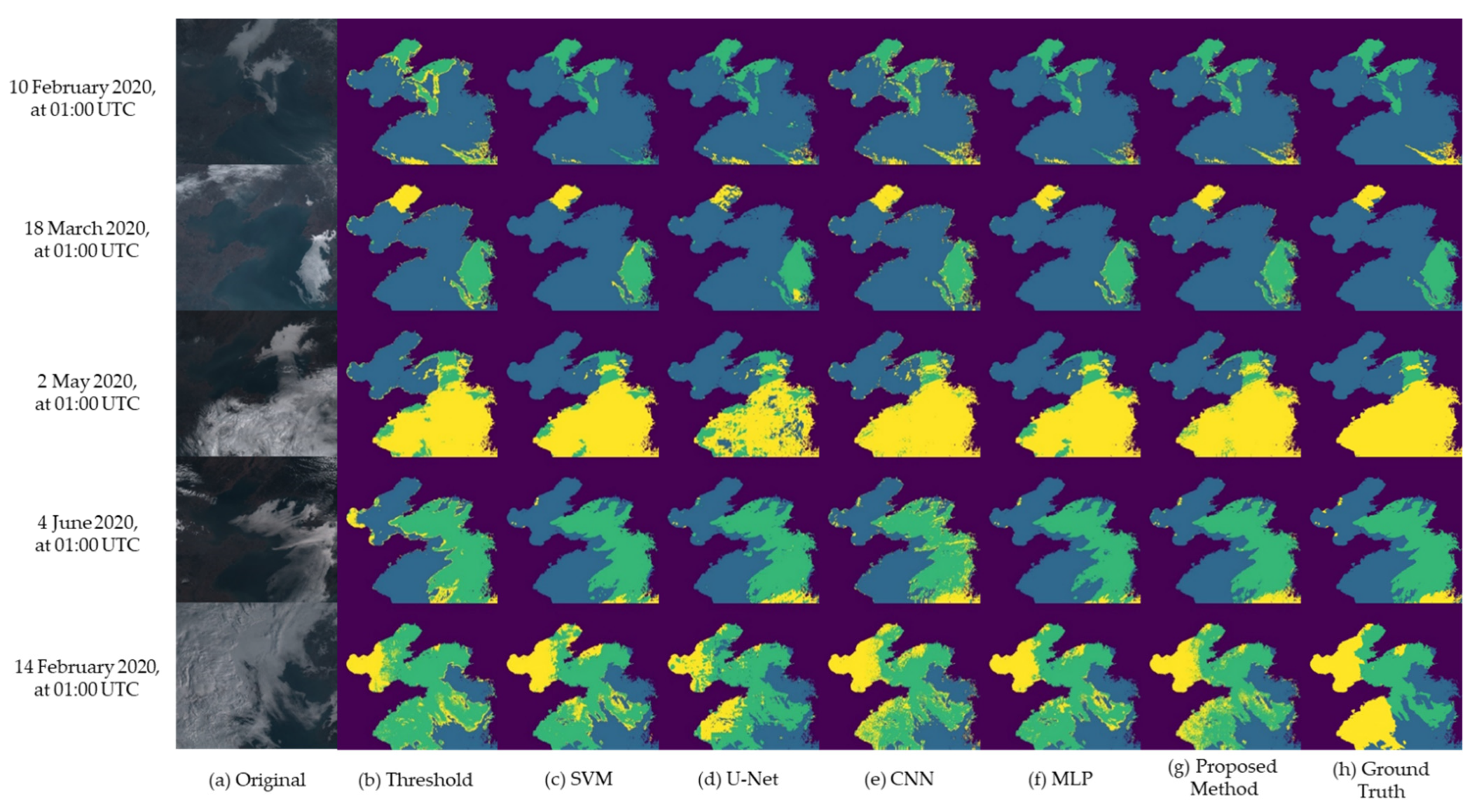

| Band | Wavelength (μm) | Spatial Resolution (km) | |
|---|---|---|---|
| Visible | 1 | 0.47 | 1 |
| 2 | 0.51 | ||
| 3 | 0.64 | 0.5 | |
| Near-infrared | 4 | 0.86 | 1 |
| 5 | 1.6 | 2 | |
| 6 | 2.3 | ||
| Infrared | 7 | 3.9 | |
| 8 | 6.2 | ||
| 9 | 6.9 | ||
| 10 | 7.3 | ||
| 11 | 8.6 | ||
| 12 | 9.6 | ||
| 13 | 10.4 | ||
| 14 | 11.2 | ||
| 15 | 12.4 | ||
| 16 | 13.3 |
| Size | FAR | POD | CSI | ERR | KSS |
|---|---|---|---|---|---|
| 33 | 0.088 | 0.936 | 0.711 | 0.083 | 0.848 |
| 65 | 0.059 | 0.919 | 0.758 | 0.064 | 0.860 |
| 97 | 0.067 | 0.889 | 0.717 | 0.076 | 0.822 |
| 129 | 0.054 | 0.875 | 0.733 | 0.069 | 0.821 |
| Method | FAR | POD | CSI | ERR | KSS |
|---|---|---|---|---|---|
| SVM | 0.070 | 0.898 | 0.718 | 0.077 | 0.828 |
| MLP | 0.077 | 0.897 | 0.702 | 0.083 | 0.820 |
| VGG16 | 0.056 | 0.847 | 0.705 | 0.077 | 0.791 |
| Ours | 0.059 | 0.919 | 0.758 | 0.064 | 0.860 |
| U-Net | 0.053 | 0.885 | 0.742 | 0.067 | 0.831 |
| Threshold | 0.107 | 0.942 | 0.679 | 0.097 | 0.835 |
Publisher’s Note: MDPI stays neutral with regard to jurisdictional claims in published maps and institutional affiliations. |
© 2022 by the authors. Licensee MDPI, Basel, Switzerland. This article is an open access article distributed under the terms and conditions of the Creative Commons Attribution (CC BY) license (https://creativecommons.org/licenses/by/4.0/).
Share and Cite
Tang, Y.; Yang, P.; Zhou, Z.; Zhao, X. Daytime Sea Fog Detection Based on a Two-Stage Neural Network. Remote Sens. 2022, 14, 5570. https://doi.org/10.3390/rs14215570
Tang Y, Yang P, Zhou Z, Zhao X. Daytime Sea Fog Detection Based on a Two-Stage Neural Network. Remote Sensing. 2022; 14(21):5570. https://doi.org/10.3390/rs14215570
Chicago/Turabian StyleTang, Yuzhu, Pinglv Yang, Zeming Zhou, and Xiaofeng Zhao. 2022. "Daytime Sea Fog Detection Based on a Two-Stage Neural Network" Remote Sensing 14, no. 21: 5570. https://doi.org/10.3390/rs14215570
APA StyleTang, Y., Yang, P., Zhou, Z., & Zhao, X. (2022). Daytime Sea Fog Detection Based on a Two-Stage Neural Network. Remote Sensing, 14(21), 5570. https://doi.org/10.3390/rs14215570









